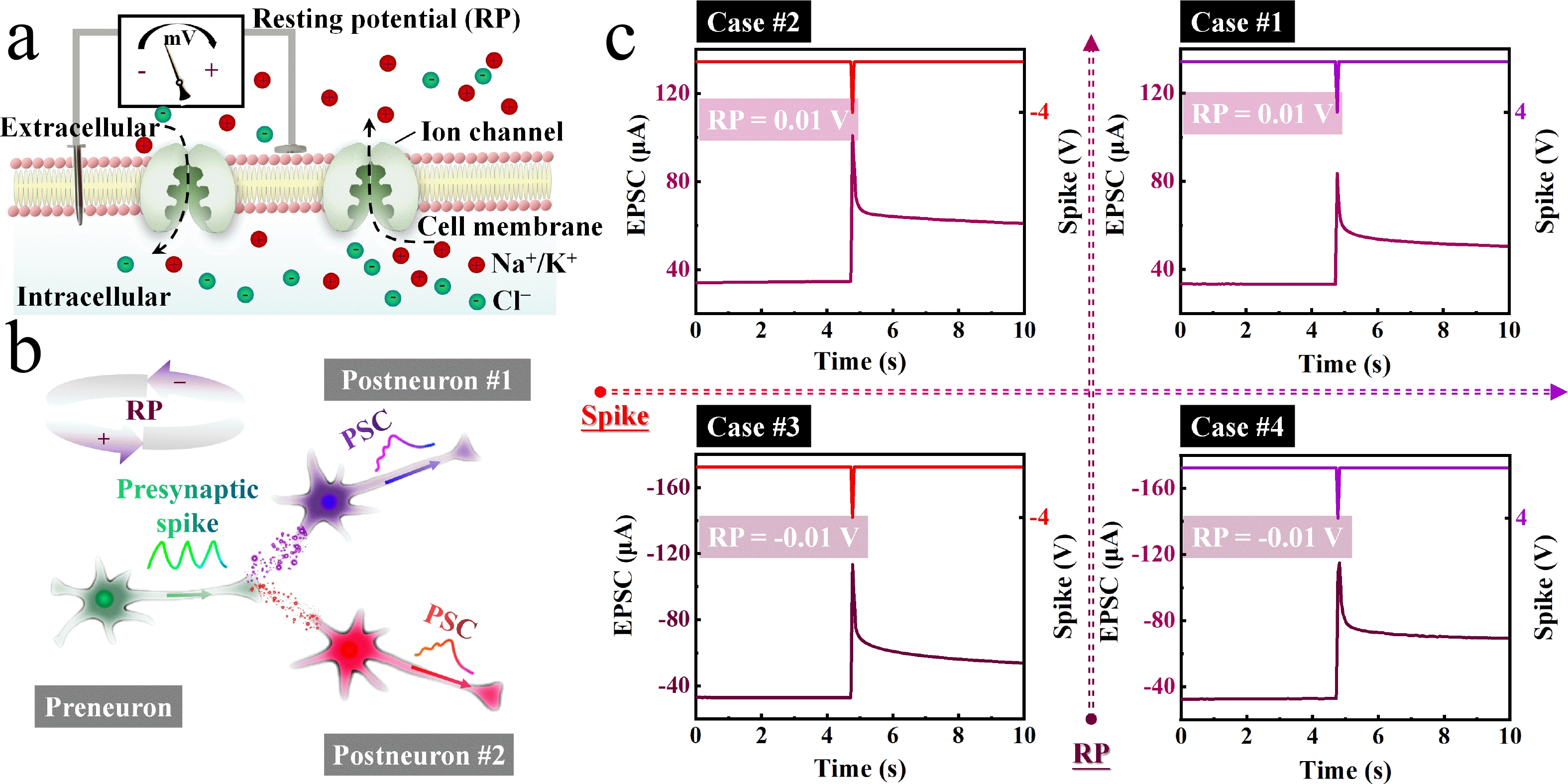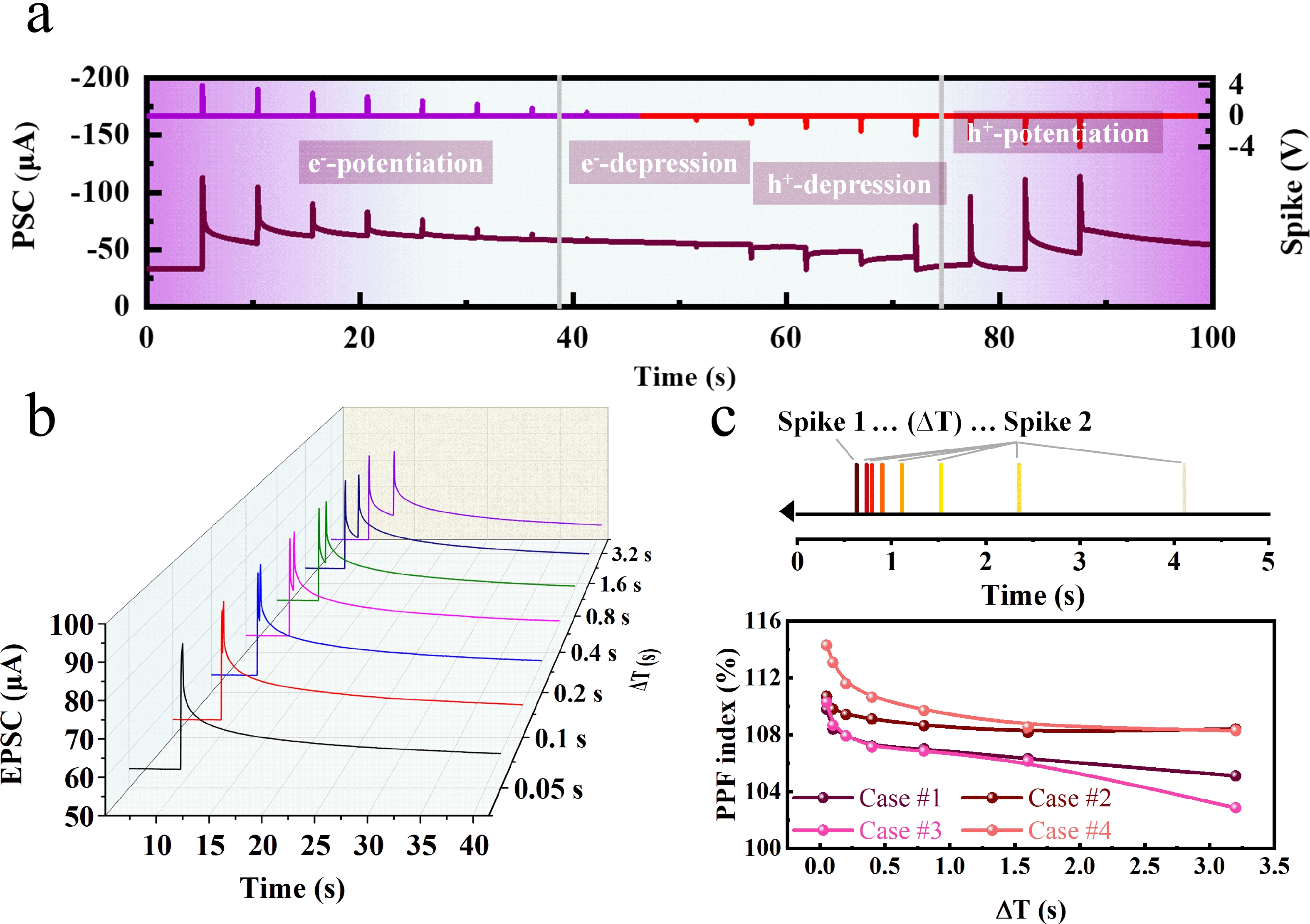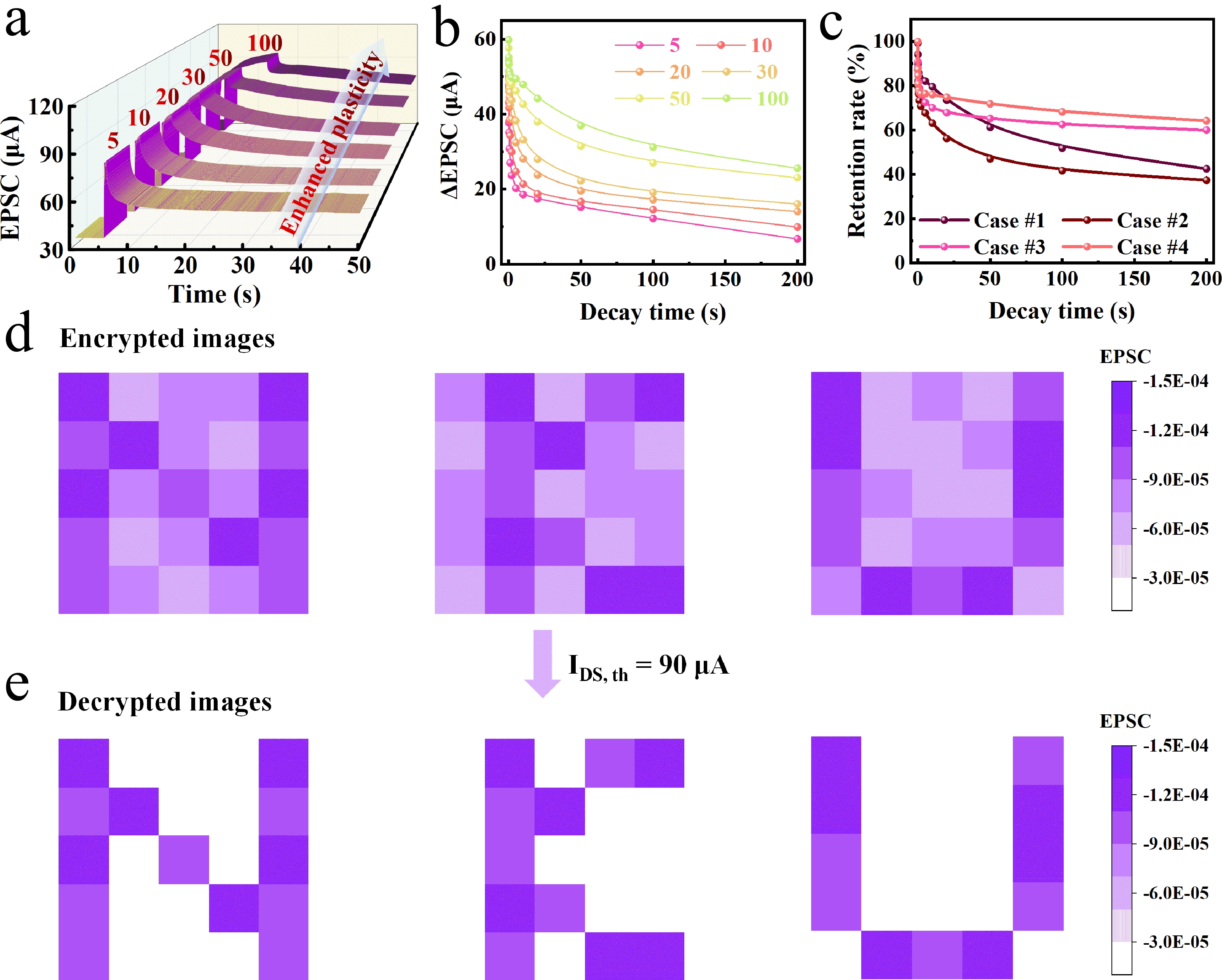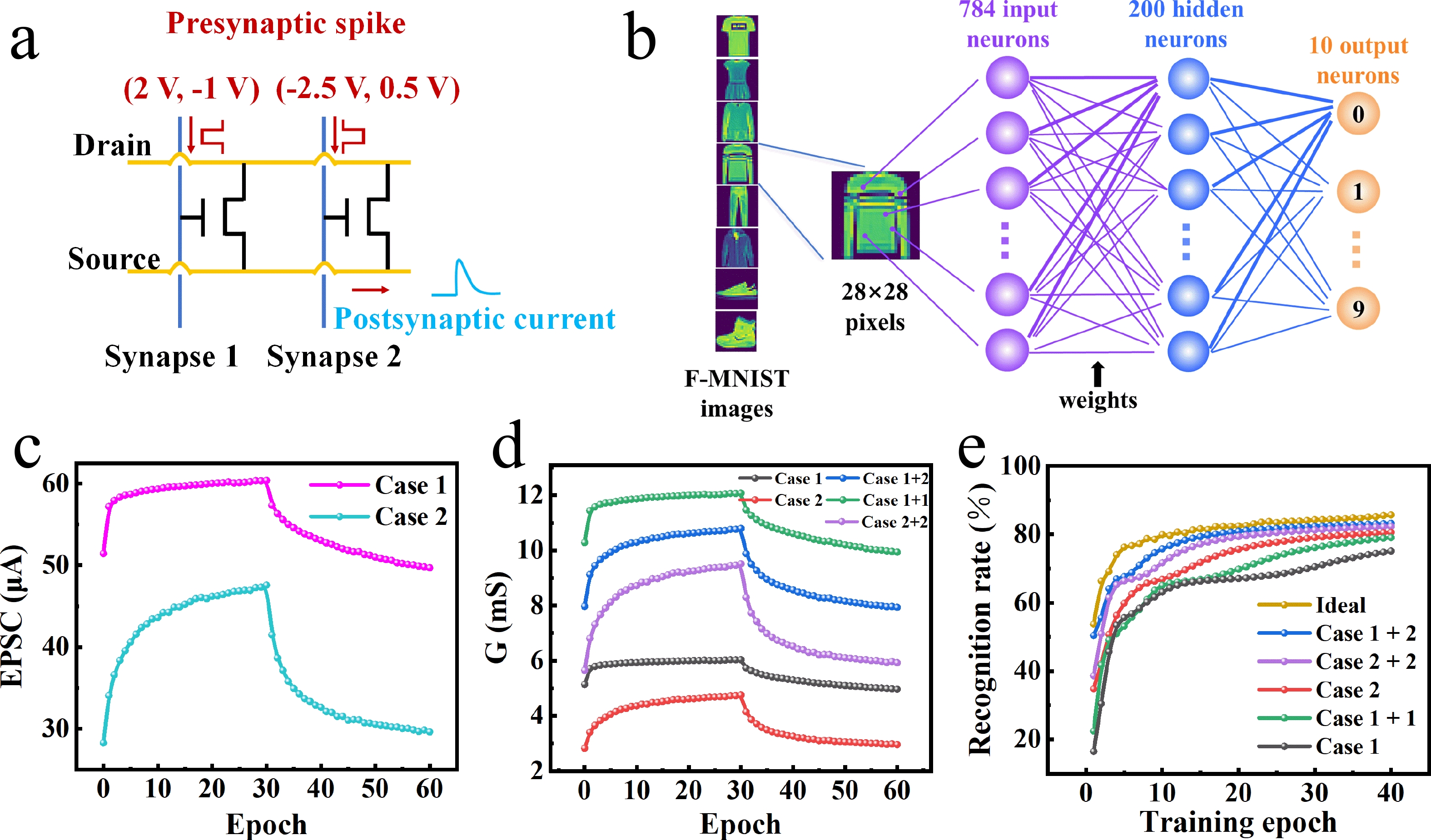| Citation: |
Zhipeng Xu, Yao Ni, Mingxin Sun, Yiming Yuan, Ning Wu, Wentao Xu. Graphene/F16CuPc synaptic transistor for the emulation of multiplexed neurotransmission[J]. Journal of Semiconductors, 2025, 46(1): 012603. doi: 10.1088/1674-4926/24080035
****
Z P Xu, Y Ni, M X Sun, Y M Yuan, N Wu, and W T Xu, Graphene/F16CuPc synaptic transistor for the emulation of multiplexed neurotransmission[J]. J. Semicond., 2025, 46(1), 012603 doi: 10.1088/1674-4926/24080035
|
Graphene/F16CuPc synaptic transistor for the emulation of multiplexed neurotransmission
DOI: 10.1088/1674-4926/24080035
CSTR: 32376.14.1674-4926.24080035
More Information-
Abstract
We demonstrate a bipolar graphene/F16CuPc synaptic transistor (GFST) with matched p-type and n-type bipolar properties, which emulates multiplexed neurotransmission of the release of two excitatory neurotransmitters in graphene and F16CuPc channels, separately. This process facilitates fast-switching plasticity by altering charge carriers in the separated channels. The complementary neural network for image recognition of Fashion-MNIST dataset was constructed using the matched relative amplitude and plasticity properties of the GFST dominated by holes or electrons to improve the weight regulation and recognition accuracy, achieving a pattern recognition accuracy of 83.23%. These results provide new insights to the construction of future neuromorphic systems. -
References
[1] Shi Y Y, Liang X H, Yuan B, et al. Electronic synapses made of layered two-dimensional materials. Nat Electron, 2018, 1, 458 doi: 10.1038/s41928-018-0118-9[2] Hou Y X, Li Y, Zhang Z C, et al. Large-scale and flexible optical synapses for neuromorphic computing and integrated visible information sensing memory processing. ACS Nano, 2021, 15, 1497 doi: 10.1021/acsnano.0c08921[3] Sharbati M T, Du Y H, Torres J, et al. Low-power, electrochemically tunable graphene synapses for neuromorphic computing. Adv Mater, 2018, 30, 1802353 doi: 10.1002/adma.201802353[4] Ni Y, Yang L, Feng J L, et al. Flexible optoelectronic neural transistors with broadband spectrum sensing and instant electrical processing for multimodal neuromorphic computing. SmartMat, 2023, 4, e1154 doi: 10.1002/smm2.1154[5] Wang H L, Zhao Q, Ni Z J, et al. A ferroelectric/electrochemical modulated organic synapse for ultraflexible, artificial visual-perception system. Adv Mater, 2018, 30, 1803961 doi: 10.1002/adma.201803961[6] Wang Y N, Zheng Y, Gao J, et al. Band-tailored van der waals heterostructure for multilevel memory and artificial synapse. InfoMat, 2021, 3, 917 doi: 10.1002/inf2.12230[7] Chen Z, Liang Q, Wei Z H, et al. An overview of in vitro biological neural networks for robot intelligence. Cyborg Bionic Syst, 2023, 4, 0001 doi: 10.34133/cbsystems.0001[8] Bai Y N, Shao S L, Zhang J, et al. A review of brain-inspired cognition and navigation technology for mobile robots. Cyborg Bionic Syst, 2024, 5, 0128 doi: 10.34133/cbsystems.0128[9] Zhou S, Li Y H, Wang Q Q, et al. Integrated actuation and sensing: Toward intelligent soft robots. Cyborg Bionic Syst, 2024, 5, 0105 doi: 10.34133/cbsystems.0105[10] Zang Y P, Shen H G, Huang D Z, et al. A dual-organic-transistor-based tactile-perception system with signal-processing functionality. Adv Mater, 2017, 29, 1606088 doi: 10.1002/adma.201606088[11] Park H L, Lee Y, Kim N, et al. Flexible neuromorphic electronics for computing, soft robotics, and neuroprosthetics. Adv Mater, 2020, 32, 1903558 doi: 10.1002/adma.201903558[12] Ni Y, Liu J Q, Han H, et al. Visualized in-sensor computing. Nat Commun, 2024, 15, 3454 doi: 10.1038/s41467-024-47630-9[13] Chen J X, Xu W T. 2D-materials-based optoelectronic synapses for neuromorphic applications. eScience, 2023, 3, 100178 doi: 10.1016/j.esci.2023.100178[14] Sun Y L, Ding Y T, Xie D. Mixed-dimensional van der waals heterostructures enabled optoelectronic synaptic devices for neuromorphic applications. Adv Funct Mater, 2021, 31, 2105625 doi: 10.1002/adfm.202105625[15] Liu Q H, Yin L, Zhao C, et al. All-in-one metal-oxide heterojunction artificial synapses for visual sensory and neuromorphic computing systems. Nano Energy, 2022, 97, 107171 doi: 10.1016/j.nanoen.2022.107171[16] Sun J, Oh S, Choi Y, et al. Optoelectronic synapse based on IGZO-alkylated graphene oxide hybrid structure. Adv Funct Mater, 2018, 28, 1804397 doi: 10.1002/adfm.201804397[17] Barker D J, Root D H, Zhang S L, et al. Multiplexed neurochemical signaling by neurons of the ventral tegmental area. J Chem Neuroanat, 2016, 73, 33 doi: 10.1016/j.jchemneu.2015.12.016[18] Seal R P, Edwards R H. Functional implications of neurotransmitter co-release: Glutamate and GABA share the load. Curr Opin Pharmacol, 2006, 6, 114 doi: 10.1016/j.coph.2005.12.001[19] Ni Y, Feng J L, Liu J Q, et al. An artificial nerve capable of UV-perception, NIR–vis switchable plasticity modulation, and motion state monitoring. Adv Sci, 2022, 9, 2102036 doi: 10.1002/advs.202102036[20] Ni Y, Liu L, Liu J Q, et al. A high-strength neuromuscular system that implements reflexes as controlled by a multiquadrant artificial efferent nerve. ACS Nano, 2022, 16, 20294 doi: 10.1021/acsnano.2c06122[21] Wei H H, Xu Z P, Ni Y, et al. Mixed-dimensional nanoparticle-nanowire channels for flexible optoelectronic artificial synapse with enhanced photoelectric response and asymmetric bidirectional plasticity. Nano Lett, 2023, 23, 8743 doi: 10.1021/acs.nanolett.3c02836[22] Liu L, Ni Y, Liu J Q, et al. An artificial autonomic nervous system that implements heart and pupil as controlled by artificial sympathetic and parasympathetic nerves. Adv Funct Mater, 2023, 33, 2210119 doi: 10.1002/adfm.202210119[23] Chen L, Wang L, Peng Y, et al. A van der waals synaptic transistor based on ferroelectric Hf0.5Zr0.5O2 and 2D tungsten disulfide. Adv Electron Mater, 2020, 6, 2000057 doi: 10.1002/aelm.202000057[24] Tian H, Cao X, Xie Y J, et al. Emulating bilingual synaptic response using a junction-based artificial synaptic device. ACS Nano, 2017, 11, 7156 doi: 10.1021/acsnano.7b03033[25] Lang F F, Pang J D, Bu X H. Stimuli-responsive coordination polymers toward next-generation smart materials and devices. eScience, 2024, 4, 100231 doi: 10.1016/j.esci.2024.100231[26] Ni Y, Ma M X, Wei H H, et al. Multiplexed neurotransmission emulated for emotion control. Nano Energy, 2021, 86, 106038 doi: 10.1016/j.nanoen.2021.106038[27] Ma M X, Ni Y, Chi Z R, et al. Multiplexed neurochemical transmission emulated using a dual-excitatory synaptic transistor. NPJ 2D Mater Appl, 2021, 5, 23 doi: 10.1038/s41699-021-00205-4[28] Wei P, Wang X D, Li X L, et al. Reconfigurable multifunctional ambipolar polymer-blend transistors with improved switching-off capability. Adv Funct Mater, 2021, 31, 2103369 doi: 10.1002/adfm.202103369[29] de Oteyza D G, Barrena E, Ossó J O, et al. Thickness-dependent structural transitions in fluorinated copper-phthalocyanine (F16CuPc) films. J Am Chem Soc, 2006, 128, 15052 doi: 10.1021/ja064641r[30] Liu N, Chortos A, Lei T, et al. Ultratransparent and stretchable graphene electrodes. Sci Adv, 2017, 3, e1700159 doi: 10.1126/sciadv.1700159[31] Cheng Z G, Zhou Q Y, Wang C X, et al. Toward intrinsic graphene surfaces: A systematic study on thermal annealing and wet-chemical treatment of SiO2-supported graphene devices. Nano Lett, 2011, 11, 767 doi: 10.1021/nl103977d[32] Ferrari A C. Raman spectroscopy of graphene and graphite: Disorder, electron phonon coupling, doping and nonadiabatic effects. Solid State Commun, 2007, 143, 47 doi: 10.1016/j.ssc.2007.03.052[33] Rasouli H R, Kaiser D, Neumann C, et al. Critical point drying of graphene field-effect transistors improves their electric transport characteristics. Small Meth, 2023, 7, 2300288 doi: 10.1002/smtd.202300288[34] Meric I, Han M Y, Young A F, et al. Current saturation in zero-bandgap, top-gated graphene field-effect transistors. Nat Nanotechnol, 2008, 3, 654 doi: 10.1038/nnano.2008.268[35] Yao Y, Huang X N, Peng S A, et al. Reconfigurable artificial synapses between excitatory and inhibitory modes based on single-gate graphene transistors. Adv Electron Mater, 2019, 5, 1800887 doi: 10.1002/aelm.201800887[36] Wang H M, Wu Y H, Cong C X, et al. Hysteresis of electronic transport in graphene transistors. ACS Nano, 2010, 4, 7221 doi: 10.1021/nn101950n[37] Ou Q Q, Yang B, Zhang J Y, et al. Degradable photonic synaptic transistors based on natural biomaterials and carbon nanotubes. Small, 2021, 17, 2007241 doi: 10.1002/smll.202007241[38] Cooke S F, Bliss T V P. Plasticity in the human central nervous system. Brain, 2006, 129, 1659 doi: 10.1093/brain/awl082[39] Fortune E S, Rose G J. Roles for short-term synaptic plasticity in behavior. J Physiol Paris, 2002, 96, 539 doi: 10.1016/S0928-4257(03)00009-3[40] Xu Z P, Ni Y, Han H, et al. A hybrid ambipolar synaptic transistor emulating multiplexed neurotransmission for motivation control and experience-dependent learning. Chin Chemical Lett, 2023, 34, 107292 doi: 10.1016/j.cclet.2022.03.015[41] Pavlov I P. Conditioned reflexes: An investigation of the physiological activity of the cerebral cortex. Ann Neurosci, 2010, 17, 136[42] Seo S, Jo S H, Kim S, et al. Artificial optic-neural synapse for colored and color-mixed pattern recognition. Nat Commun, 2018, 9, 5106 doi: 10.1038/s41467-018-07572-5[43] Qian C, Oh S, Choi Y, et al. Rational band engineering of an organic double heterojunction for artificial synaptic devices with enhanced state retention and linear update of synaptic weight. ACS Appl Mater Interfaces, 2020, 12, 10737 doi: 10.1021/acsami.9b22319 -
Supplements
 24080035Supplementary_Material.pdf
24080035Supplementary_Material.pdf

-
Proportional views

§Zhipeng Xu, Yao Ni, and Xinlin Geng contributed equally to this work and should be considered as co-first authors.




 Zhipeng Xu got his Bachelor's degree in 2019 from East China University of Technology and his Master's degree in 2022 from Nankai University. He is currently a Ph.D. candidate at the College of Electronic Information and Optical Engineering, Nankai University. His research focuses on 2D materials, flexible electronics and artificial synaptic transistors.
Zhipeng Xu got his Bachelor's degree in 2019 from East China University of Technology and his Master's degree in 2022 from Nankai University. He is currently a Ph.D. candidate at the College of Electronic Information and Optical Engineering, Nankai University. His research focuses on 2D materials, flexible electronics and artificial synaptic transistors. Yao Ni obtained Ph.D. in 2023 from Nankai University. Currently, he holds a position as a Lecturer at Guangdong University of Technology and also serve as a Visiting Research Fellow at the University of Hong Kong. He is guiding a group of researchers in exploring biocompatible artificial synaptic transistors sensitive to time-frequency signals, multimodal signal-sensing artificial peripheral nerves, and in-sensor computing.
Yao Ni obtained Ph.D. in 2023 from Nankai University. Currently, he holds a position as a Lecturer at Guangdong University of Technology and also serve as a Visiting Research Fellow at the University of Hong Kong. He is guiding a group of researchers in exploring biocompatible artificial synaptic transistors sensitive to time-frequency signals, multimodal signal-sensing artificial peripheral nerves, and in-sensor computing. Mingxin Sun got his Bachelor of Science degree in 2018 from China University of Mining and Technology. Now he is a Master's student at the College of Electronic Information and Optical Engineering, Nankai University. His research focuses on electrohydrodynamic printing and the characterization and testing of neuromorphic devices based on amorphous metal oxides and graphene nanoribbons.
Mingxin Sun got his Bachelor of Science degree in 2018 from China University of Mining and Technology. Now he is a Master's student at the College of Electronic Information and Optical Engineering, Nankai University. His research focuses on electrohydrodynamic printing and the characterization and testing of neuromorphic devices based on amorphous metal oxides and graphene nanoribbons. Yiming Yuan got his Bachelor's degree (2016) and Master's degree (2020) from Chongqing University of Posts and Telecommunications (CQUPT). He is currently a Ph.D. candidate at the College of Electronic Information and Optical Engineering, Nankai University (NKU). His research interests include perovskite memristors and artificial synapses.
Yiming Yuan got his Bachelor's degree (2016) and Master's degree (2020) from Chongqing University of Posts and Telecommunications (CQUPT). He is currently a Ph.D. candidate at the College of Electronic Information and Optical Engineering, Nankai University (NKU). His research interests include perovskite memristors and artificial synapses.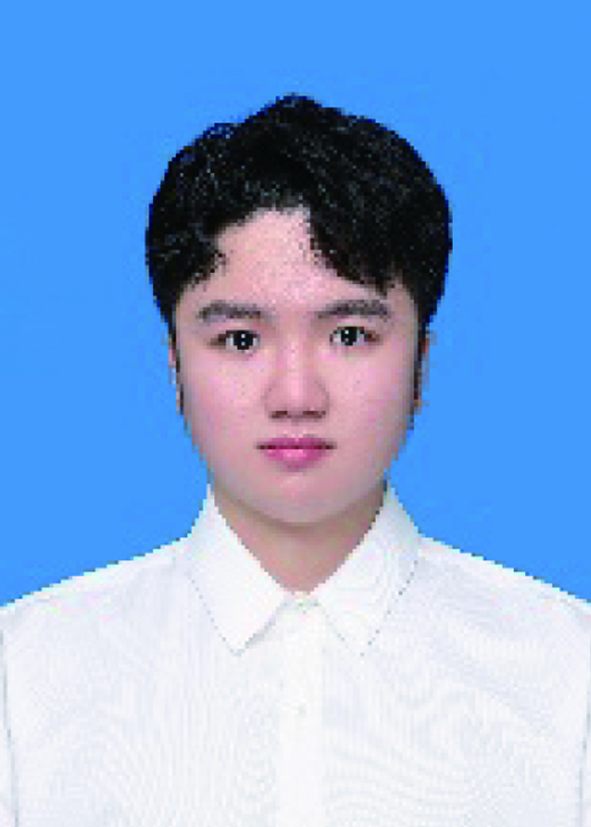 Ning Wu graduated from Hefei University of Technology in 2023 with a Master's degree. Now, he is a Ph.D. candidate studying in the College of Electronic Information and Optical Engineering, Nankai University. His research interests include organic semiconductors, organic thin-film transistors and artificial synaptic devices.
Ning Wu graduated from Hefei University of Technology in 2023 with a Master's degree. Now, he is a Ph.D. candidate studying in the College of Electronic Information and Optical Engineering, Nankai University. His research interests include organic semiconductors, organic thin-film transistors and artificial synaptic devices. Wentao Xu is a professor in the College of Electronic Information and Optical Engineering, Nankai University. He received his B.S. at Beijing Normal University and his Ph.D. at the Pohang University of Science and Technology (POSTECH). He had been a research associate professor at Seoul National University (SNU), and visiting scholar at Stanford University and the University of Illinois at Urbana-Champaign. His research interests include neuromorphic electronic devices, flexible electronics, electrohydrodynamic nanowire printing, memory devices, and thin-film transistors.
Wentao Xu is a professor in the College of Electronic Information and Optical Engineering, Nankai University. He received his B.S. at Beijing Normal University and his Ph.D. at the Pohang University of Science and Technology (POSTECH). He had been a research associate professor at Seoul National University (SNU), and visiting scholar at Stanford University and the University of Illinois at Urbana-Champaign. His research interests include neuromorphic electronic devices, flexible electronics, electrohydrodynamic nanowire printing, memory devices, and thin-film transistors.
 DownLoad:
DownLoad:
